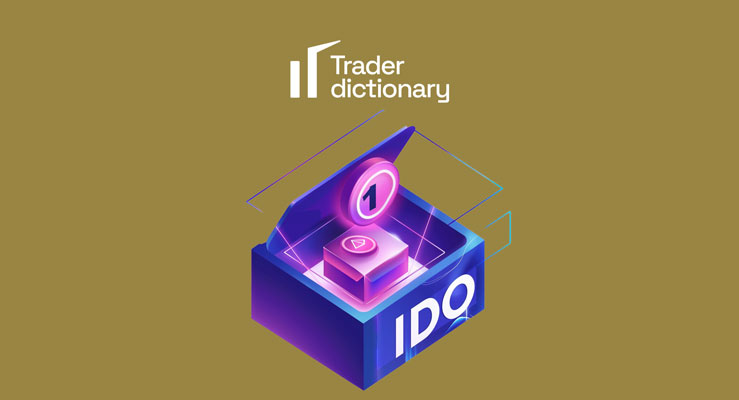In the rapidly changing world of blockchain and cryptocurrencies, Initial DEX Offerings (IDOs) have become an indispensable part of many people’s investment strategies. This article will guide you step by step, from the basic definition of IDO, why they are important, to how they work. Join us to uncover and clarify one of the central concepts in the modern trading world, through analysis, real-life examples, and useful advice, so you not only understand what IDOs are but also how to apply this knowledge to your own investment practices.
What is an Initial DEX Offering (IDO) in Crypto?
IDO, or Initial DEX Offering, is an emerging fundraising method in the crypto world, where projects directly release their tokens on a decentralized exchange (DEX). This is a significant step forward from the traditional Initial Coin Offering (ICO) method we often hear about. With IDOs, speed is key – tokens can be traded immediately, bringing significant benefits to both investors and issuers.
Now, why choose IDO? The answer lies in the flexibility and security it provides. Unlike ICOs, where fundraising is often not tightly controlled, IDOs are conducted on existing DEX platforms, helping to minimize the risk of fraud. At the same time, it also provides an ideal environment for token liquidity, something investors always crave.
However, it’s not always smooth sailing. Some challenges of IDOs include high price volatility immediately after release and the potential to be overwhelmed by large investors, or “whales”. To address this, some projects have adopted measures such as limiting the number of tokens that can be purchased in the early stages, to create fairer conditions for everyone.
Remember, IDOs are not just a way to raise funds; they are also an opportunity to build community and enhance trust in your project. And there, my friends, lies the reason why IDOs are so crucial in this volatile crypto world. Don’t forget, whether you’re an investor or an issuer, always do thorough research before jumping into any IDO project. It’s not just about smart investing, but also how you protect yourself from potential risks.
The Difference between IDO and IEO
IDOs and IEOs, both are means for blockchain projects to raise funds, but oh boy, how they differ!
Starting with IDO – Initial DEX Offering. This is how projects release their tokens directly on a decentralized exchange (DEX). The idea here is simple – want people to buy your tokens? IDO makes this easier by removing any intermediaries. It’s like hosting a party yourself and inviting everyone over. But, remember, there’s no security here. Risks? Yes. Opportunities? Plenty!
Switching to IEO – Initial Exchange Offering. This is a completely different ball game. IEOs are conducted by centralized exchanges (CEXs). They vet your project from head to toe before agreeing to issue tokens. It’s like having a reputable organizer endorse your party. Safer? Absolutely. But they also take their cut from the party.
In essence, IDOs and IEOs are like two different event organizing styles. IDOs offer flexibility and freedom but come with high risks. IEOs are safer but require you to accept control from the exchange. Which to choose? Depends on how you want to play the game.
How IDOs Work in the Crypto World
First off, a project wanting to conduct an IDO must choose a suitable DEX. This is crucial, as it affects how many users the project can reach. Then, they announce details about the IDO, including the number of tokens to be sold and their price. It’s like announcing tickets for a highly exclusive event.
Next, when the IDO starts, investors have the chance to buy tokens. This is where things get exciting! Everyone tries to buy tokens as fast as possible, as they’re usually limited. And don’t forget, since it’s on a DEX, all transactions are transparent and fair.
Finally, after the IDO concludes, tokens are listed on the DEX and begin trading freely. This is when the project really starts to “take off”. I feel IDOs are not just an opportunity to raise funds but also a way to build community and trust.
Truly, IDOs are an integral part of a cryptocurrency project’s journey. They offer opportunities, but also no small number of challenges. I always get excited thinking about the innovation and opportunities IDOs bring to the crypto market.
How to Launch an IDO
Step 1: Business Planning
To successfully launch an IDO, the first thing to do is to create a solid business plan.
- Define Goals and Vision: Be clear about the long-term goals of the project and how the IDO supports achieving those goals. Goals should be specific, measurable, achievable, relevant, and time-bound.
- Market Analysis: Have a deep understanding of the target market, including competitors and potential customers. This helps identify specific opportunities and challenges in the industry.
- Create a Business Model: Determine how the project will generate revenue and profit. The business model should reflect the unique value the project brings to users.
- Financial Planning: Forecast finances, including startup budget, operational costs, and cash flow. This is crucial to ensure the project has enough capital for development and expansion phases.
- Build a Team: Choose a team with the right skills and experience to execute the project. The team should have diverse skills, including product development, marketing, finance, and project management.
- Legal and Compliance: Ensure the project complies with all legal regulations related to cryptocurrencies and financial transactions. This includes registering with regulatory bodies and protecting investor rights.
- Marketing and Communication Strategy: Develop a detailed marketing plan to build awareness about the project and attract investors. This plan should include media campaigns, events, and community-building activities.
This first step determines a lot about the success of the IDO, so make sure everything is thoroughly prepared!
Step 2: Creating Marketing Materials
After the business plan, the next step in the IDO process is to create quality marketing materials.
- Develop Website and Landing Page: A professional website and landing page for the IDO are essential to introduce the project and attract investors. This page should provide comprehensive information about the project, roadmap, team, and IDO details.
- Create Whitepaper: The whitepaper is a foundational document detailing the project, including the business model, technology, token mechanics, and IDO information. The whitepaper should be professionally written and easy to understand.
- Develop Brand Identity: Standardize logos, color schemes, and other design elements to create a consistent and professional brand image across all marketing channels.
- Produce Marketing Content: Includes creating blog posts, social media posts, introduction videos, and other materials to introduce the project and IDO. Content should be engaging, compelling, and provide real value to the audience.
- Design Email Campaigns: Create email campaigns to send updates about the project and IDO to subscribers. Emails should be professionally designed and personalized to increase open and engagement rates.
- Build a Community: Use platforms like Telegram, Discord, and Twitter to build a supportive community for the project. Engage regularly and initiate discussions to increase community bonding.
- Prepare FAQ Document: Prepare a FAQ document to answer common questions about the project and IDO. This helps reduce confusion and build trust with investors.
Quality marketing materials are key to attracting attention and building trust with investors, so make sure everything is meticulously and professionally done.
Step 3: Working with a DEX Platform
Choosing a suitable DEX platform is the next important step in launching your IDO.
- Research and Select DEX: Start by researching popular DEX platforms and evaluating them based on reputation, trading volume, and user community. Choosing a DEX that fits your project is crucial.
- Understand DEX Mechanisms: Each DEX operates differently, from pricing mechanisms to token listing procedures. Make sure you understand these to optimize your IDO launch strategy.
- Engage with the DEX Community: Many DEXs have vibrant and supportive communities. Engaging with this community can help you understand DEX operations better and how best to interact with potential investors.
- Comply with DEX Regulations: Each DEX has its own set of regulations for IDO launches. Ensure your project complies with all requirements to avoid any delays or legal issues.
- Determine Fees and Listing Costs: Understand the fees associated with launching an IDO on a DEX, including listing fees, transaction percentages, and any other applicable charges.
- Collaborate with DEX for Marketing Optimization: Many DEXs offer marketing support services for IDO projects. Working closely with the DEX to maximize these resources can help enhance awareness and success for your IDO.
- Prepare Thoroughly for Launch Day: Ensure everything is ready for launch day, from technical systems to marketing strategies. Thorough preparation will make the launch process smoother.
Working closely with a DEX platform not only ensures your IDO is launched efficiently but also maximizes the chances of success in fundraising and community building.
Step 4: Creating Your Cryptocurrency
Creating your own cryptocurrency is the next step after planning, developing marketing materials, and working with a DEX platform.
- Define Token Objectives: First, be clear about the purpose of creating the token. Does it serve a specific function in your project? Or is it designed to raise funds? This determines the structure and features of the token.
- Choose the Right Token Standard: There are various token standards, such as ERC-20 for Ethereum or BEP-20 for Binance Smart Chain. Choose the standard that meets your project’s needs and is supported by your chosen DEX.
- Develop Smart Contracts: Smart contracts are the core of any token, managing issuance, transactions, and other rules. This should be done by experienced developers to ensure safety and efficiency.
- Test Smart Contracts: Before issuance, smart contracts need to be thoroughly tested to identify and fix any errors. This helps avoid technical and financial risks.
- Determine Supply and Demand: Decide on the number of tokens to be issued, distribution methods, and any token burning mechanisms to adjust supply and demand. This affects the value and scarcity of the token.
- Comply with Legal Requirements: Ensure the token issuance complies with all current legal regulations related to cryptocurrencies and securities. This may require professional legal consultation.
- Develop and Distribute Wallets: Users will need a place to store and trade your token. Ensure that the wallet supports your token standard and is user-friendly.
- Plan for Token Management Post-IDO: This includes planning for listing on other exchanges, community management, and project updates.
Creating your cryptocurrency is not just a technical task; it involves strategic planning and ensuring the token has real value and a clear purpose in the project ecosystem.
Step 5: Release the Token to Start Fundraising Immediately
Finally, releasing the token to start fundraising is the decisive step in the IDO process.
- Determine Token Price: Set the price for the token based on market evaluation, project value, and fundraising goals. The price should balance attracting investors and ensuring fair value for the project.
- Plan Distribution: Determine how and when tokens will be distributed to investors, including allocations for the development team, advisors, and community fundraising. Ensure this process is transparent and fair.
- Conduct a Pre-sale: Pre-sales help draw attention and boost funds for the project before the official IDO. This also helps gauge market interest.
- Execute a Strong Marketing Campaign: Continue marketing campaigns before and during the IDO to raise awareness about the project and attract investors. Use social media, PR, and online events to maximize reach.
- Ensure Security and Compliance: Ensure transaction security using advanced security technology and comply with legal regulations. This includes KYC (Know Your Customer) and AML (Anti-Money Laundering) procedures if required.
- Monitor and Support the Fundraising Process: Use tracking tools to monitor the fundraising process and be ready to support investors with any issues that arise. Prompt and efficient support increases the success chances of the IDO.
- Manage the Community Post-IDO: Maintain engagement and support with the community after the IDO to build trust and retain investors. Regular updates on project progress and future plans are crucial.
Releasing the token and starting fundraising is the most critical step in the IDO process. Thorough preparation, smart strategy, and active community engagement play a decisive role in achieving fundraising goals.








